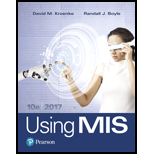
Explanation of Solution
Processes:
Processes contain sequence of interconnected activities that produces result by converting inputs into outputs.
- Activity is a sub-part of a process.
- Activities in processes include getting inputs, manipulating and producing corresponding output, which are interrelated to one another.
- Activities can be done either by human or by computer systems.
Types of processes:
There are two different types of processes. They are:
- Structured processes
- Dynamic processes
Structured Processes:
- Structured processes are standardized and they mostly contain the same and fixed sequence of activities.
- The flow of activities in structure processes does not change.
Example:
Booking flight tickets:
Here, the user enter their details and some processes takes place internally like, if the seats are available, then the tickets are produced, if the seats are not available, then the tickets are not produced for that particular flight. In this, the procedures to get tickets for all the users are same and so it is called as structured processes.
Dynamic Processes:
- Dynamic processes are not standardized. It is less structured.
- The flow of activities in dynamic processes gets change according to the current trend. It is more strategic and more adaptive.
- This type of processes needs human judgement.
Example:
Programs in TV channels:
Programs in a high rated channel get changed more frequently according to the response of the audience in order to increase Television Rating Point (TRP rate).
Differences between structured and dynamic processes:
| Structured Processes | Dynamic Processes |
| Structured processes are standardized and they are highly structured. | Dynamic processes are less structured. |
| The flow of processes does not change. | The flow of processes gets changed frequently. |
| It is formal in nature. | It is informal. |
| It supports operational activities and there is no need of human judgement in structured processes. | It supports strategic activities and so this processes needs human judgement. |
| Example: Booking flight tickets | Example: Programs in TV channels. |
Workgroup processes:
Workgroup processes achieve goals of a particular department by implementing groupwork.
Example:
Human Resources’ involvement is important in recruitment process, compensation, assessment and HR planning. The HR department in specific company gets performance of an employee from various departments and process overall rating for that particular employee.
Enterprise processes:
Enterprise processes provide the organization to sustain longer and it supports the activities performed in various departments.
Example:
In a corporate company, the process of recruiting a person supports activities in financial department, the employee’s specialized department, and so on...
Want to see the full answer?
Check out a sample textbook solution
Chapter 7 Solutions
Using MIS (10th Edition)
- What early use-cases for the unified process model did you build with clients in collaboration? Give three examples of how a system may be put to use.arrow_forwardThe digital enterprise is defined as a new paradigm that shifts the focus from conventional information management to orchestrating services and workflows. Describe an example workflow for an electronic publishing (e-publishing) company.Your workflow should include information on all stages right from the gathering of material from the author to the end-consumer purchase. How can this be maintained in an IS? How is this different from the workflow of a traditional publishing company? Do you think one workflow is better than the other? Justify your answer using examples and reasoning.arrow_forward1. Define what Continuous build and integration systems mean. 2. Describe what a continuous build and integration system would look like for the management system provided in the class diagram below. You should cover : What systems need to be set up? How users (developers) of the system would interact with them? and What the outputs would look like ?arrow_forward
- During the Inception phase of the unified process model, did you collaborate with customers to develop preliminary use-cases? Describe three possible use cases for a system in advance.arrow_forwardExplore the challenges and solutions associated with system management strategies for large-scale, distributed systems, such as those used in multinational corporations.arrow_forward1. What are the advantages of Continuous Integration (CI) in making applications with an agile approach? 2. Look for a product (software app) that can describe the Versioning concept in development, software for example WhatsApp, Zoom, Facebook. Describe? the answers based on configuration management on software engineering!arrow_forward
 Principles of Information Systems (MindTap Course...Computer ScienceISBN:9781305971776Author:Ralph Stair, George ReynoldsPublisher:Cengage Learning
Principles of Information Systems (MindTap Course...Computer ScienceISBN:9781305971776Author:Ralph Stair, George ReynoldsPublisher:Cengage Learning Fundamentals of Information SystemsComputer ScienceISBN:9781337097536Author:Ralph Stair, George ReynoldsPublisher:Cengage Learning
Fundamentals of Information SystemsComputer ScienceISBN:9781337097536Author:Ralph Stair, George ReynoldsPublisher:Cengage Learning

